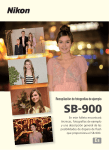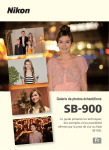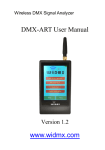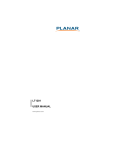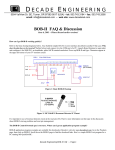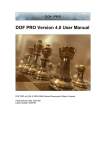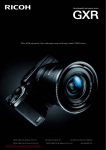Download A Collection Of Example Photos SB-900
Transcript
A collection of example photos SB-900 This booklet introduces techniques, example photos and an overview of flash shooting capabilities possible when shooting with an SB-900. En Selecting suitable illumination pattern The SB-900 provides three illumination patterns with differing light falloff at image edges. Select a pattern suitable to your shooting environment. • To change illumination pattern, refer to “Switching illumination pattern” in the SB-900 user’s manual. Standard illumination Optimized for digital photography and suitable for various shooting conditions Illumination is set to standard as the default. Standard illumination has been designed to provide light distribution that matches the image area of digital cameras. This means that light falloff at the edges of the image is less than with conventional external flash units. Standard illumination is appropriate for typical flash shooting environments. Equipment used Camera: D3 / Lens: AF-S NIKKOR 24-70mm f/2.8G ED / Speedlight: SB-900 Center-weighted illumination Suitable for portraits and other such shots in which light falloff at image edges can be ignored Center-weighted illumination provides larger guide numbers at the center of the image than other illumination patterns at the same focal length (the light falloff at the edges will be greater than with other illumination patterns). Suitable for portraits and other such shots in which the light falloff at the edges of the image can be ignored, or backlit shots in which flash lighting with larger guide numbers is effective. 2 Equipment used Camera: D3 / Lens: AF-S NIKKOR 24-70mm f/2.8G ED / Speedlight: SB-900 Even illumination Suitable for shooting indoor group photographs with bright image edges The light falloff at the edges of the image is less than with standard illumination. Suitable for shooting indoor group photographs in which sufficient light is required without light falloff at the edges. Equipment used Camera: D3 / Lens: AF-S NIKKOR 24-70mm f/2.8G ED / Speedlight: SB-900 3 Bounce flash Provides more natural-looking pictures Bounce flash When photographing a subject standing in front of a wall, tilt or rotate the flash head up to bounce light off the ceiling. This softens the light falling on the subject and eliminates the shadow behind and below the subject. By using a Nikon Diffusion Dome, you can achieve a greater bounce flash effect. • To take bounce flash photographs, refer to “Bounce flash operation” in the SB-900 user’s manual. • To soften the shadows behind a subject, tilt the flash head up 90° and bounce the flash off the ceiling. • This diffuses and softens the flash light to give subtle face and skin tones. • When bounce flash is not used, the subject’s face is rendered shiny and strong shadows appear behind. Equipment used Camera: D3 Lens: AF-S NIKKOR 24-70mm f/2.8G ED Speedlight: SB-900 4 with softer shadows Normal flash Reference Tilting the flash head and choosing a reflecting surface • The more the flash head is tilted upward, the more the flash light is softened. • Rotate the flash head horizontally to achieve the same effect when holding the camera in the vertical position. • The effective shooting distance between the flash head and the reflecting surface is approx. 1 m (3.3 ft.) to 2 m (6.6 ft.) depending on shooting conditions. 90º • With color photography, select white or highly reflective surfaces to bounce the light off. Otherwise, pictures will come out with an unnatural color cast similar to that of the reflecting surface. 5 Compensate the brightness and color shading of the subject Flash head tilts up 90° • Compare the effects of bounce flash with the flash head tilted up 90°, 75° and 105°. 75° 90° • The larger the tilt angle of the flash head, the wider the flash light is spread and more evenly the subject is illuminated. However, image brightness is reduced. • When the flash is bounced off a wall or ceiling behind the camera, the flash light is more evenly spread, providing weaker shadow and more natural-looking photographs, although image brightness is reduced. • To achieve the desired bounce flash effect, adjust the tilt angle of the flash head, checking the results as you shoot. When shooting with short focal lengths, use a larger tilt angle, and when shooting with long focal length, use a smaller tilt angle. Equipment used Camera: D3 Lens: AF-S NIKKOR 24-70mm f/2.8G ED Speedlight: SB-900 6 105° by changing the flash head tilting angle Bounce flash Flash head tilts up 75° Flash head tilts up 105° (bounce the light off the wall behind the camera) 7 Taking portraits using catch light Using the built-in bounce card (close-up photography) • To create highlights in the subject’s eyes, tilt the SB-900 up 90° to bounce the light off the ceiling, and use the SB-900 built-in bounce card. • This technique makes the eyes look more vibrant. With the built-in bounce card Without the built-in bounce card 8 • This technique also softens shadows around eyes, cheeks and chin by illuminating the front of the subject. Equipment used Camera: D3 Lens: AF-S NIKKOR 24-70mm f/2.8G ED Speedlight: SB-900 Built-in bounce card Bounce flash Taking portraits with soft flash light for natural-looking skin With the Nikon Diffusion Dome Without the Nikon Diffusion Dome • Attach the provided Nikon Diffusion Dome over the flash head to soften shadows and further diffuse flash light when bouncing flash light off the ceiling. • Without the Nikon Diffusion Dome, shadows appear on cheeks, chin and ribbon. With the Diffusion Dome, the diffused flash light creates a soft, natural-looking image. Equipment used Camera: D3 / Lens: AF-S NIKKOR 24-70mm f/2.8G ED / Speedlight: SB-900 / Nikon Diffusion Dome 9 Shooting with color filters Adjust the color temperature of the flash to match that of the overall scene illumination To match the color temperature of the subject illuminated with flash light and background illuminated with incandescent lighting, use one of the provided incandescent filters. • For shooting with color filters, refer to “Shooting with color filters” in the SB-900 user’s manual. • To compensate for the color of background incandescent illumination, use an incandescent filter. • When an incandescent filter is used, the color of the main subject and the background are evenly balanced. An incandescent filter used with the camera’s white balance set to “Incandescent”. • When the color filter is not used, objects in the background that are not illuminated by the flash appear somewhat red. Equipment used No incandescent filter used with the camera’s white balance set to “Flash (Speedlight)”. 10 Camera: D3 / Lens: AF-S NIKKOR 24-70mm f/2.8G ED / Speedlight: SB-900 / Incandescent filter TN-A1 / Color Filter Holder SZ-2 Auto FP High-Speed Sync Provides natural-looking lighting to main and background subjects in backlit conditions Auto FP High-Speed Sync is effective in backlit shooting conditions in which the face of the subject is dark. Auto FP High-Speed Sync uses flash light to supplement sunlight. Use a wider aperture and faster shutter speeds to capture a sharp main subject and background bokeh. • Provides subject’s face and hair with firmness and detail although sunlit from behind. The flash light illuminates the face, achieving bright and natural colors. With flash light • When flash light is not used, the subject’s face is poorly lit. Equipment used Without flash light Camera: D3 / Lens: AF-S NIKKOR 24-70mm f/2.8G ED / Speedlight: SB-900 11 Slow-sync flash shooting Take natural-looking pictures With slow-sync flash Atmospheric evening shots or night landscapes can be captured with the use of a slow shutter speed that correctly exposes both the main subject and the background. • To take images with a large depth of field, use slow-sync flash to illuminate both the foreground subject and the background. In addition, use a wide aperture to blur the background to emphasize the main subject. • When slow-sync flash is not used, background subjects are not illuminated sufficiently and appear dark. Equipment used Camera: D3 Lens: AF-S NIKKOR 24-70mm f/2.8G ED Speedlight: SB-900 12 illuminating both foreground subject and background. Without slow-sync flash Description of images on pages 14-15 How different shutter speeds and apertures affect an image. • A slow shutter speed provides a colorfully lit subject and a bright background. A • A fast shutter speed results in weak colors in the foreground and a dull, indistinct background. B • A wide aperture heightens bokeh to provide a stunning night view image. C • A small aperture results in weak bokeh and greater depth of field. D A C B D Equipment used Camera: D3 Lens: AF-S VR Zoom-Nikkor 70-200mm f/2.8G IF-ED Speedlight: SB-900 Equipment used Camera: D3 Lens: AF-S NIKKOR 24-70mm f/2.8G ED Speedlight: SB-900 13 Taking night shots with a bright main subject and natural-looking background A Slow-sync flash (1/8 sec., f/2.8) B Standard shutter speeds (1/250 sec., f/2.8) 14 Slow-sync flash shooting Change the aperture to vary the amount of background bokeh C Slow-sync flash with large aperture (1/30 sec., f/2.8) D Slow-sync flash with small aperture (1/30 sec., f/11) 15 Wireless multiple flash shooting Take group photos Three flash units (on-camera + left front + right side) In combination with CLS-compatible cameras, the SB-900 facilitates wireless multiple flash shooting using Nikon Advanced Wireless Lighting. • For more about wireless multiple flash shooting, refer to “Wireless multiple flash shooting” in the SB-900 user’s manual. • Use direct light from the flash unit attached to the camera to illuminate the subjects, and use two flash units, one to the left and one to the right, to reduce shadows and diffuse the light of the entire image, including the background. • The right side flash unit is placed high up. The Nikon Diffusion Dome is attached to this unit to soften the light and provide a solid appearance to the subjects and a clear background. • The third flash unit, placed on the left side, is used to bounce light off the wall to emphasize the subjects and illuminate the entire image from front to back. • When the subjects are illuminated with only the flash unit attached to the camera, strong shadows appear, and depth and background texture are poorly represented. 16 with foregrounds and backgrounds illuminated with soft, diffused light With only the flash unit attached to the camera Position of flash units (Three flash units) Remote: SB-900 with Nikon Diffusion Dome Equipment used Camera: D3 Lens: AF-S NIKKOR 24-70mm f/2.8G ED Speedlight: SB-900 x 3 Nikon Diffusion Dome Remote: SB-900 Master: D3 + SB-900 17 Using multiple lighting to achieve depth, texture and color Three flash units (front + rear left + right side) • The violin is mainly illuminated with the front flash unit, with bounced lighting added from the rear left and direct lighting from the right to achieve a rich violin shape. • Illuminate the violin from rear left using relatively strong bounce flash lighting to emphasize the shape of the violin and give texture to the image. • Illuminate the subject with soft lighting from the right flash unit to achieve depth of color and texture. • When illuminated only with the flash unit attached to the camera, the image appears flat, and detail and texture are poor. 18 Wireless multiple flash shooting With only the flash unit attached to the camera Position of flash units (Three flash units) Remote: SB-900 Remote: SB-900 Equipment used Camera: D3 Lens: AF-S NIKKOR 24-70mm f/2.8G ED Speedlight: SB-900 x 3 Master: D3 + SB-900 19 NIKON CORPORATION Printed in Europe Printed in Japan TT8F01 (11) TT8F01(11) 8MSA3411-01 8MSA3511-01




















